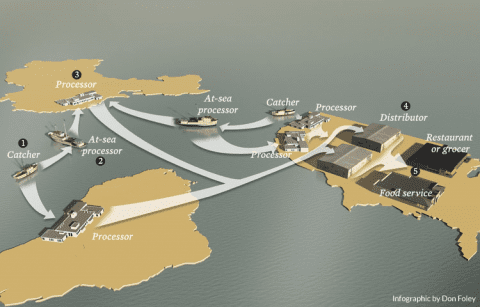Infographic: What is the Path Your Seafood Takes?
Have you ever asked yourself, “What is the Path My Seafood Takes?” It’s not as easy to figure out as you might think. More than 90% of seafood eaten in the U.S. is imported, and it follows an increasingly complex path from a fishing boat to our plates.

Here are the steps your fish may take before it gets to you:
Step 1: Most seafood is either caught by fishing vessels or raised in aquaculture facilities. Fish and shellfish can be put on ice or flash-frozen on board the vessel or at the aquaculture facility.
Step 2: During primary processing, the head and guts of the fish are removed, making it easier to transport and prevent spoilage. At this point, the vessel may take its catch to shore for processing on land. However, for many fisheries, giant at-sea processing vessels collect seafood from many catcher vessels, then remove the head and gut the fish while crossing the ocean. These at-sea processors and transport vessels frequently deliver fish to large plants in countries where labor is cheaper to begin secondary processing of the fish.
Step 3: Secondary processing includes thawing the fish to allow trimming, deboning, breading, cooking and packaging for wholesale or retail sales. At this stage, the fish is refrozen and labeled as a “product of” the country where processing takes place, often omitting where it was farmed or captured.
Step 4: Finally, the seafood is exported to the U.S. and enters the same product supply chain as most prepared foods, where it may be thawed again to sell in ready-to-eat form. Domestically produced seafood follows a similar supply chain but may have a shorter distance to travel.
Step 5: Seafood is often sold through specialty distributors or may be sourced nationwide. Wholesale and retail food service establishments, including restaurants, grocery stores, cafeterias, hospitals and institutions, then sell seafood to consumers.



